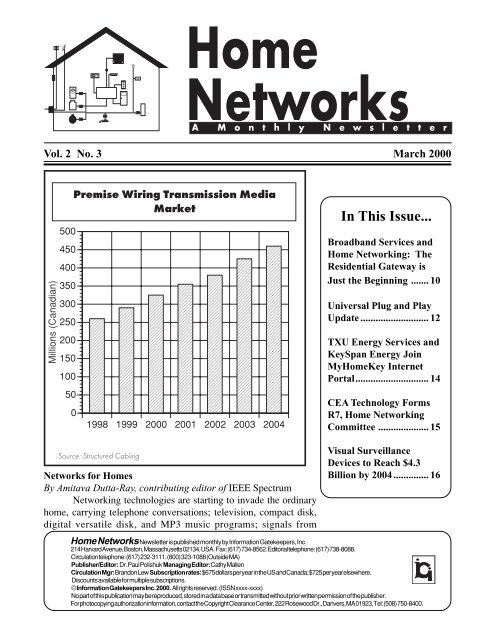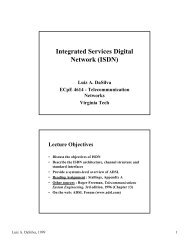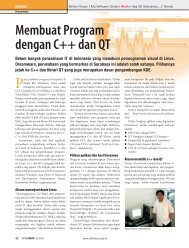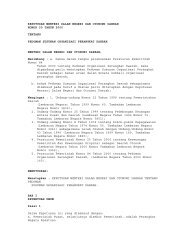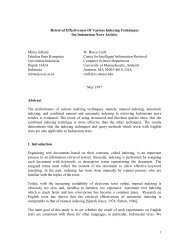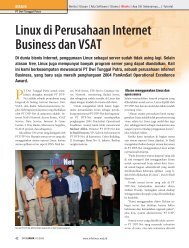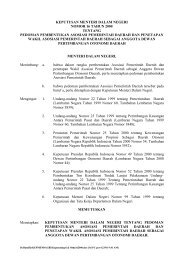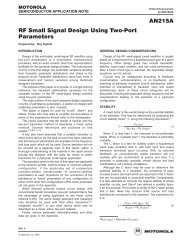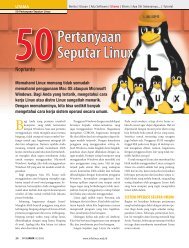Home Networks- March 00 - Kambing UI
Home Networks- March 00 - Kambing UI
Home Networks- March 00 - Kambing UI
You also want an ePaper? Increase the reach of your titles
YUMPU automatically turns print PDFs into web optimized ePapers that Google loves.
<strong>Home</strong> <strong>Networks</strong> Newsletter <strong>March</strong> 2<strong>00</strong>0surveillance cameras; commands for controlling appliances; and multimedia flows from the Internet.With home networking, it is also possible for electric utilities to remotely control the flow of electricityinto individual homes and to(read their meters automatically.“For years, the focus has been on the last mile (of cable to the home); but that is only half thesolution. The home network , consisting of about the last 1<strong>00</strong> yards, will complete the broadbandaccess scenario,” said Cyrus Namazi, director for consumer connectivity at Advanced Micro DevicesInc. in Sunnyvale, CA, and chairman and president of the <strong>Home</strong> Phoneline Networking Alliance(<strong>Home</strong>PNA) in San Ramon, CA.The present foray is moving at a relaxed pace, entering into relatively few multiple-dwellingunits and some small businesses. But there is no doubt that the pace will accelerate in a year or twowhen the equipment becomes more affordable. At present, these networks fall into two main applicationsareas: computer interconnection, accessing the Internet, and connecting multiple PCs withperipherals for communications and entertainment. The networks control items such as lights,appliances, climate-control systems, and surveillance cameras.Prime candidates for home networks are homes with two or more computers, an estimated 17million homes in the US alone. The physical basis of these networks is frequently voice-grade telephonewiring or slightly more expensive Category 5 twisted pairs, but electric power lines are also being used, asare wireless schemes, mainly in the 2.4 GHz unlicensed industrial, scientific, and medical (ISM) band.To succeed, home networks must be based on standard products operable with any of the mediajust mentioned. These products include transceivers, network interface cards, gateways, small servers,sensors, and controllers, plus a widely accepted operating system. To achieve mass market appeal, thenetworks will need to be inexpensive, easy to install, and include software that is easy to configure andoperate. <strong>Home</strong> owners, after all, cannot afford to hire information technology managers.Many of the players in the home networking arena are start-ups or have been in the business foronly a short time. Several are established and multibillion-dollar companies including Cisco, Intel,Nortel, Motorola, Lucent, 3Com, IBM, and Panasonic, who either have bought into the fledgling concernsor have joint developments and licensing arrangements with them. Some of these heavy hittersare betting on more than one networking medium, hoping to benefit no matter which one succeeds.In general, the competitors, especially the start-ups, are loath to give many details of the technologiesthey are deploying. Even the specifications of trade consortia are available to their membersonly. But some exceptions exist. There are the IEEE 802.11 specification for wireless adapted forhome networking; Lon Works, an operating system for home automation developed by Echelon Corp.of Palo Alto, CA, which is an open standard under EIA 709; and the Consumer Electronics Bus (CEBus)networking standard under EIA 6<strong>00</strong> (Electronic Industries Alliance). The owner of another proprietarytechnology, X10, which controls appliances over electric power lines in the home, publishes the specificationsof the transmitting devices only. Manufacturers of home appliances can design and embedX10 transmitters in them, while receiving and controlling devices are made by the company that ownsthe technology, X10 Ltd., of Hong Kong.As noted, there are two distinct markets for home networking. One comprises computer interconnectionand entertainment and requires high-speed networks. The other is control, which can behandled by slower networks. Karuna Uppal, senior analyst at the Yankee Group, a market researchfirm in Boston, projects that by 2<strong>00</strong>1, the total annual revenue form home data and entertainmentnetworking will hit close to US$725 million. “Phone-line home networking will become pervasiveCopyright 2<strong>00</strong>0 Information Gatekeepers Inc. 214 Harvard Ave. Boston MA 02134 Tel: (617) 232-3111 Fax: (617) 734-85622
<strong>Home</strong> <strong>Networks</strong> Newsletter <strong>March</strong> 2<strong>00</strong>0once 10 Mbps products are available by the end of 1999 and early 2<strong>00</strong>0,” said Brian Palmer, informationtechnology research analyst for connectivity and computer networking at market researcher, Frost& Sullivan Inc., Mountain View, CA.The largest market right now for home networking involves control: heating, ventilating, andair-conditioning systems; lighting; pumps and sprinklers; and security. Total spending may top $2.75billion by the end of 2<strong>00</strong>0, according to Navin Sabharwal, an analyst at Allied Business Intelligence,Oyster Bay, NY. Automation here could yield big savings because such equipment, which tends toconsume large amounts of electricity, could be controlled to make its operation more efficient.“Currently, the greatest impediment to creating a residential network is, surprisingly, a lack ofuseful wiring. Most existing dwellings do not have a single unused twisted-wire pair in appropriatelocations, and retrofit is expensive,” said Earl Grey of Control Contractors, Seattle, WA. There is alsono single affordable medium that meets all of the requirements, so the coexistence of all media willcontinue for some time.Under a heavy marketing campaign by IBM Corp., among others, some new homes in the USare being built with home networking in mind. In particular, homes are structured with the wiringconcept introduced years ago when local-area networks were first installed in offices. With structuredwiring, the networking lines come into the office at a single point (the wiring closet) and radiate outfrom there. Thus IBM, which has developed a new product line for home networking, is trying topersuade consulting and construction companies to build in such structured wiring. All lines, includingCategory 5 twisted wire-pairs for Ethernet networks, telephone wire-pairs, power lines, and RG-6coaxial cables for video distribution, would come in through that single point.IBM hopes to sell the new homeowner its <strong>Home</strong> Director products, to be installed by authorizeddistributors. <strong>Home</strong> Director consist of control modules, connectors, and a connection centerlocated in the wiring closet. Through the center it can control and manage all of the various computersand devices on the network, including entertainment, data, or control. The system allows for assertingcontrol from any point on the network and remotely.The first outpost in the home is not the connection center, but a broadband gateway to theInternet. This gateway might contain a cable modem, an asymmetric digital subscriber-line modem, asatellite receiver, a wireless transceiver, or combinations of these items, depending on the choice of thehomeowner. Manufacturers of networking products operating over phone lines are probably the bestorganized to present persuasive arguments for their technology, and to standardize product specifications,though they would not handle cable-TV signals.The <strong>Home</strong> Phoneline Networking Alliance was formed in June 1998 by 11 companies, includingwell-known names such as 3Com, Advanced Micro Devices, AT&T Wireless Systems, CompaqComputer, Hewlett-Packard, Intel, IBM, and Lucent Technologies. Their purpose was to draft a set ofindustry wide standards. Currently, <strong>Home</strong>PNA, as it is known, has a roster of more than 1<strong>00</strong> members,a quarter of whom are from outside the US. Note that home networking (networking within the home)over telephone wiring should not be confused with asymmetric digital-subscriber line (ADSL) technology,which is used to connect homes and offices with the Internet at speeds of up to about 6 Mbps.Because they are already in place in a residence, phone lines have a good shot at capturing alarge share of home networks. Their devices must be simple to configure and use, and secure fromoutside intrusion, scalable, and able to support high data rates, on the order of one to several Mbps.They cannot cost the consumer more than $1<strong>00</strong> per node, according to market analysts.Copyright 2<strong>00</strong>0 Information Gatekeepers Inc. 214 Harvard Ave. Boston MA 02134 Tel: (617) 232-3111 Fax: (617) 734-85623
<strong>Home</strong> <strong>Networks</strong> Newsletter <strong>March</strong> 2<strong>00</strong>0But there is a problem. Residential phone lines, though excellent for voice signals, were notdesigned to carry high-speed data. Their attenuation and impedance characteristics are not well controlled.Tut Systems Inc., Pleasant Hill, CA, was perhaps the first company to get around these problemsand develop a scheme for handling high-speed signals over such phone lines. It employs frequency-divisionmultiplexing to create three channels, each for a different purpose: to provide ordinaryphone service (dc-34<strong>00</strong> Hz), ADSL signals to access the Internet (25 kHz to 1.1 MHz), andnetworking for entertainment programs and computer data (5.5-9.5 MHz).In its networking channel, Tut transfers data a 1Mbps over a band between 5.5 and 9.5 MHz,with 7.5MHz as the carrier frequency. Within this passband Tut uses the well-established technologyof the IEEE 802.3 carrier-sensing multiple access with collision detection (CSMA/CD), which is commonlyassociated with Ethernet. But it encapsulates Ethernet frames within larger packets. To transferpackets at high-speed, the company employs a patented pulse-position modulation technique to boostthroughout by encoding multiple bits into each transmitted pulse, or signaling element.Tut’s 1-Mbs technology has been adopted in the first <strong>Home</strong>PNA network specification, release1.0, released in 1999. Transmitters and receivers have equalizing filters to improve the characteristicsof the telephone lines, thereby reducing the bit error rate. To further boost reliability, received data isverified with a conventional cyclic redundancy check.There is a question as to whether signals on a wire pair going to one apartment in a multipledwelling unit could electro-magnetically couple into an adjacent pair going elsewhere. According toGeorge Minassian, chair of the <strong>Home</strong>PNA Technical Committee and director of the Advanced DevelopmentLaboratory at AMD, a maker of chip sets used in <strong>Home</strong>PNA devices, no significant securityrisks arise from such coupling. To alleviate interference emanating from the dwelling, a filter at thenetwork interference device (the point of entry of the Internet data into the home) would keep thesignals from travelling outside. Vendors of <strong>Home</strong>PNA release 1.0-compliant products, including DiamondMultimedia Systems, Best Data Products, and Linksys Group. Intel Corp. makes chip sets for<strong>Home</strong>PNA and sells a complete home networking system of its own under the brand AnyPoint.A transfer rate of 1 Mbps is, of course, considered slow for transmitting bit streams, of videoprograms compressed to MPEG-2 standards of 2-4 Mbps, DVD video of 3-8 Mbps, or high-definitionTV at 19 Mbps. But theoretically, it would be possible to transfer data at up to 1<strong>00</strong> Mbps over homephone lines using certain portions of the 2-30 MHz band. This capability is the basis of a secondrelease of the <strong>Home</strong>PNA specification proposed by Epigram Inc. of Sunnyvale, CA (which was recentlyacquired by Broadcom Corp. of Irvine, CA), and Lucent Technologies Inc. of Allentown, PA.Release 2.0 would support data rates up to 10 Mbps while maintaining full backward compatibilitywith the first release. A bandwidth between 4 and 10 MHz with 7 MHz as the carrier frequency wouldbe used for this purpose.Release 2.0 employs frequency diversity quadrature amplitude modulation (FDQAM), inwhich the same QAM information is repeated in two separate frequency regions to increase therobustness of data transfer, and to ensure that the information is not attenuated or corrupted. Arate-adaptive two bits per baud will yield data rates in the range of 4-32 Mbps. Bell Atlantic, thegiant telephone company that serves most of the Eastern United States, including New York, announcedon October 6, 1999, that it will partner with Tut Systems, Lynksys, 3Com, and DiamondMultimedia in an experiment to install home networking platforms for phone lines to work withthe digital subscriber-line service it already offers.Copyright 2<strong>00</strong>0 Information Gatekeepers Inc. 214 Harvard Ave. Boston MA 02134 Tel: (617) 232-3111 Fax: (617) 734-85624
<strong>Home</strong> <strong>Networks</strong> Newsletter <strong>March</strong> 2<strong>00</strong>0As for the international standardization of specifications for home networking over phone lines,the Geneva-based International telecommunication Union (ITU) has a forum (Question 4/Study Group15) for receiving proposals from member countries for inclusion in its approved recommendation,dubbed G.pnt (for Phone Network Tranceivers). The study group is the same one that developed theADSL standards and is currently working on the standards for very high-speed digital subscriber lines(VDSLs). This should enhance the synergies between home networking using phone lines and theXDSL family of standards.This step will also help to address serious concerns about the risk that phone networking transceiverswill interfere with VDSL and vice versa. Although the deployment of VDSL may have to waitthree years, the problem of this interference must be addressed now. British Telecom has proposed theinstallation of a filter at the network interface device, which is a costly solution since it will require atelco technician to install the filter.“With careful coordination of the respective systems, both home phone networks and VDSLcan be made to share the same wire without adverse effect,” said John Cioffi, professor of electricalengineering at Stanford University.Telephone jacks may not be available in every nook and cranny of a home, but chances are thatthe power outlets will be. Accordingly, efforts have been underway for years to use electrical wiring orcommunicating between different areas of the home. Since 1978, Radio Shack has been selling asystem called X10, which consists of a control box and several modules. Each module (roughly 70mm high, 53 mm wide, and 30 mm deep) plugs into an electrical outlet like any other electrical appliance.The modules have two 16-step wheels so each can be assigned a distinct code. Electrical appliancesare then plugged into the bottom of the module.The control box can be plugged into an outlet anywhere in the household, and used to controlappliances plugged into any of the remote modules. The module’s code may be punched on the smallkeypad of the controller together with the appropriate command. Control signals may also be generatedin a computer, co that it is possible to remotely program the on/off sequence of devices.Control pulses consist of 120 KHz bursts within one ms envelope. A binary 1 is a burst; theabsence of a burst within an envelope is a binary 1. The transmissions signals are synchronized bysending them as close as possible (within 2<strong>00</strong>ms) of the zero crossing point of the 60 Hz power-linefrequency. Because the data packets are short, communication between X10 devices can achieve ahigh degree of reliability. Simple appliance modules are priced as low as $9.95, and control units are$14.95 and up, depending on their features.Some models of the X10 appliance modules not only receive commands but can also be polledand will transmit signals back to the central controller indicating their status. This feature is helpful,for example, to remotely check on the temperature of a home or its boiler, or to turn on a surveillancecamera. A Brazilian electric utility, Compania Energetica de Minas Gerais (Cemig), in the state ofMinas Gerais, uses this feature to help it distribute power equitably during hours of peak demand.To gain such capability, the electric company first used a pair of 20-A circuit breakers to modifythe standard 40-A panels through which many homes are supplied. It can then switch off one breakerduring hours of peak demand. In order to give the householder some incentive for allowing thechangeover to the 20-A breakers, the charge for using electricity during off-peak hours is lower.Cemig is also applying X10 to automatic meter reading. Usage data is stored in the meter bythe residential X10 unit, which is polled once a month by a control unit at the distribution transformer.Copyright 2<strong>00</strong>0 Information Gatekeepers Inc. 214 Harvard Ave. Boston MA 02134 Tel: (617) 232-3111 Fax: (617) 734-85625
<strong>Home</strong> <strong>Networks</strong> Newsletter <strong>March</strong> 2<strong>00</strong>0From there the readings from a group of homes can be downloaded to a laptop computer. X10 Ltd.,which designs its own chips for its devices, manufactures products for companies that include IBM,Thomson (GE and RCA brands), Philips (Magnavox brand), Radio Shack, Leviton, Honeywell, Stanley,Ademco, and ADT. IBM, for example, relies on X10 technology in its <strong>Home</strong> Director product. Accordingto Dave Rye, X10’s vice president and technical manager, the company has shipped more than1<strong>00</strong> million units.Use of power lines for any data rate higher than a few bits per second, as employed in X10technology, presents many technical problems. Among them are noise and interference, attenuation,and impedance variations and the reflections they cause. Several technologies claim to surmount theseproblems, and protocols for such communications processes have been formalized by industry consortia.CEBus (EIA 6<strong>00</strong>) is an open standard that specifies the technology and the parameters for communicationsusing power lines, Category 5 twisted-wire pair, coaxial cable, wireless, and infrared.The media access layer (MAC) of CEBus employs carrier-sensing multiple access with collisiondetection and collision resolution (CSMA/CDCR). This allows any device on the network toaccess the medium at any time. However, a node wishing to send a data packet must first sense that noother packet is on the line at that moment, and only if the line is clear may it send its packet. This isvery similar to the protocol of IEEE 802.3 local-area networks. CEBus also specifies a commonapplication language (CAL) that enables devices to communicate amongst themselves and to performcertain tasks using common rules of syntax and vocabulary. Each device is defined as a “context” inCAL including stereo players and VCRs.Each context of CAL is further divided into objects. These objects represent functions such asvolume, treble, or bass. Command signals can identify contexts and activate function controls, such asraising the volume of a stereo player. Receivers attached to devices interpret the commands and actupon them. Since cEBus is an open standard, a CEBus controller designed by one vendor should beable to operate with a CEBus-compatible device manufactured by any other vendor. The CEBusIndustry Council publishes information on CEBus and CAL. Several companies are selling CEBusproducts for electric line control and communications.Ocala, Florida-based Intellon Inc. achieves a high data rate over electric power lines by employinga spread-spectrum carrier technology similar to the one used in wireless communications. Forhigh data rates, Intellon employs orthogonal frequency-division multiplexing (OFDM), which involvessending data over multiple subcarriers.The use of OFDM technology deals with multiple reflections — a major source of interferencein power line communications. Using this multiplexing technology, it is theoretically possible to transferdata at better than 1<strong>00</strong> Mbps, according to Intellon. Another company working with this kind oftechnology is Enikia Inc. of Piscataway, NJ, but it has not yet introduced products.Intelogis Inc. of Draper, UT, takes a different tack to power-line communications. It transmitsdata in a frequency band above the region in which most noise is found. Dubbed Plug-in PLX technology,it uses a combination of datagram-sensing multiple access (DSMA) and centralized token passing(CTP). DSMA acts in a similar fashion to the multinode contention resolution of an Ethernet network.A node, when entering the network for the first time, detects the carrier of other packets on the line,sending its own packet only if it is clear to do so.Once all the nodes are known to each other, a dynamic, centrally-distributed token passingscheme is instituted. This avoids multinode contention and collision and thus raises the effectiveCopyright 2<strong>00</strong>0 Information Gatekeepers Inc. 214 Harvard Ave. Boston MA 02134 Tel: (617) 232-3111 Fax: (617) 734-85626
<strong>Home</strong> <strong>Networks</strong> Newsletter <strong>March</strong> 2<strong>00</strong>0throughput. Intelogis claims that its technology permits simultaneous transfer of small control packetsand entertainment data, say of MP3, without interfering with each other. Plug-in PLX conforms to theCEBus CAL. Current versions of Intelogis products support a bit rate of 350 Kbps. A chip set allowing2 Mbps will be available to equipment manufacturers around the first part of next year, ToddGreen, director of product marketing, Intelogis Power Line Networking, told Spectrum.Another player is Itran Communications Ltd. of Beer Sheva, Israel. It designs chips for bothspread spectrum and OFDM that handle data rates of 1.5 Mbps for home networking and home office,50 Kbps for home automation, and 7 Kbps for a secure home automation application.While emphasis is mostly on high data rate, High Tech Horizon of Angelholm, Sweden, hasbeen quietly shipping its power-line communication cards for PCs. Running at 2,4<strong>00</strong> bps, they can beused to send and receive messages and data files between PCs and peripherals. They also run a speechrecognition program so that it is possible to “talk” to the computer from any part of the home.In spite of vendor promises, the consumer has yet to see an affordable product capable of highspeedcommunication over the power line. Estimates for high-speed home networks using power linesare much lower than those using either phone lines or wireless, and there seems to be no coherent effortto make the power line communication products interoperable. The UK-based International PowerlineCommunications Forum (IPCF) is hoping to generate the momentum needed to do this.Wireless is a fast-developing technology for data and voice communications. In manysituations, wireless can provide a convenient and inexpensive networking solution in a home orsmall office.Since most homes with two or more personal computers were built before the recent explosionin telecommunications, they are not wired for a telephone in every room. Installing twisted wire-pairsall over the premises would be difficult. Wireless networks could prove very useful as an alternative.However, “current wireless standards are as bountiful as they are confusing,” Greg Naderi, an informationtechnology industry analyst at Frost & Sullivan told Spectrum. “The industry needs to reach aconsensus fairly soon before competing wireless home networking technologies capture significantmarket share.”Technologies for physical media access by wireless follow several specifications, some of whichhave been approved by independent standards bodies. One such set of specifications is the IEEE’s802.11. In conformity FCC requirements for the use of the unlicensed ISM band, IEEE 802.11 allowsboth direct-sequence (DS) and frequency-hopping (FH) spread spectrum. The maximum data rateoffered by the standard for either technique is 2 Mbps. However, a higher-speed version of IEEE802.11 allows a data rate of up to 11 Mbps. A drawback of the 802.11 protocol for data transfer in ahome network is its high overhead. The protocol was initially developed for cellular telephony.Products operating at 11 Mbps as specified by IEEE 802.11 are being beta tested by <strong>Home</strong>Wireless <strong>Networks</strong> (HWN) Inc., of Norcross, GA. Company officials told Spectrum that final productswill be ready for shipping in the first quarter of 2<strong>00</strong>0. The products are based on a complementarycode keying technology also used in products being developed by Lucent Technologies and AppleComputer Inc., said P. Stuckey McIntosh, HWN’s chief technology officer. ShareWare Inc., El DoradoHills, CA, backed by Cisco Systems, Kyushu Matsushita Electric Co., and Netgear (a subsidiary ofNortel), also plans to offer 11 Mbps devices. To accommodate video streaming and HDTV, <strong>Home</strong>Wireless <strong>Networks</strong> is working on a new technology called layered same-time processing (LST), whichpromises to deliver 50-1<strong>00</strong> Mbps over the same bandwidth as today’s 11 Mbps systems.Copyright 2<strong>00</strong>0 Information Gatekeepers Inc. 214 Harvard Ave. Boston MA 02134 Tel: (617) 232-3111 Fax: (617) 734-85627
<strong>Home</strong> <strong>Networks</strong> Newsletter <strong>March</strong> 2<strong>00</strong>0Eventually, but not any time soon, the IEEE 802.11 specifications will permit data transfer ratesof anywhere from 6 to 54 Mbps using discrete multitone (DMT), as well as orthogonal frequencydivisionmultiplexing. Most of the 11 Mbps direct-sequence systems are designed around chip setsmade by Harris Corp., Torrance, CA. However, the FCC filed a notice of proposed rule-making onJune 24, 1999 for a possible discontinuation of the use of 11 Mbps direct sequence.The next important set of specifications – one that is fairly inexpensive to deploy – has beenformalized by an industry consortium known as the <strong>Home</strong>RF Working Group and supported by manycommunications companies, most in North America. The group has produced a set of specificationsknown as the Shared Wireless Access Protocol (Swap), now in release 1.1, that uses frequency-hoppingspread-spectrum technology in the 2.4 GHz band to yield a data rate of 1 Mbps.Swap products are being shipped by Proxim Inc. under the brand name Symphony. There isalso a move to develop a higher-speed Swap. The <strong>Home</strong> RF group petitioned the FCC to increasefrequency-hopping bandwidth to 3 or 5 MHz so that it could develop 11 Mbps frequencyhoppingproducts. This topic is also included in the FCC’s notice of proposed rulemaking of June 24th.Lobbying for this ruling is strong and an official decision on the future use of spread spectrum — DSand FH – can be expected perhaps in the spring of 2<strong>00</strong>0.The European Telecommunications Standards Institute (ETSI) supports two wirelessprotocols – HiperLAN, for high-speed traffic, and Digital European Cordless Telcommunications(DECT), which operates at lower speeds. HiperLAN, in the future to be known as BRAN (BroadbandRadio Access <strong>Networks</strong>), is a set of specifications for a network operating at 5 GHz and yielding a datarate of 24 Mbps, which is sufficient for high-definition TV.There is an effort to develop a North American version of HiperLAN. However, it is not clearthat the US will require HiperLAN, since the FCC has already released the unlicensed national informationinfrastructure (UNII) band, which occupies the spectrum between 5.7250 and 5.8750 MHz.DECT, with a data rate of 1.152 Mbps, calls for the use of frequencies between 1880 and 1990MHz. So far, equipment made to DECT specifications by European firms offer only voice communications.However, <strong>Home</strong> Wireless <strong>Networks</strong>’ research laboratory in Cambridge, England, has beenable to integrate both voice and data in DECT-compliant equipment. British Telcommunications, thelargest carrier in the UK, has signed contracts with <strong>Home</strong> Wireless <strong>Networks</strong> for equipment to beinstalled in their clients’ homes.Also fairly inexpensive to implement, Bluetooth is a proposed set of specifications for shortrangeuse within the home or office. It should be possible to use Bluetooth devices to communicatewith each other, without them being tethered to some network. Ericsson of Sweden, Nokia of Finland,and Intel are the primary backers of Bluetooth, which is named for a 10 th -century Scandinavian kingwho united several Danish kingdoms.There is, of course, more to a communications system than they physical and data link layers.Once the bits are delivered in the right order, higher layers are needed to interpret the significance ofthose bits and interface with application programs. The best way to undertake that interpretation dependson whether the system is carrying high-speed communications or low-speed communications orlow-speed control signals.Aimed at control applications, LonWorks employs carrier-sense multiple-access for the physicallayer and is independent of the medium being used. That is, LonWorks can be used with phonewire-pairs, Category 5 twisted wire-pairs, power lines, and wireless. Along with X10, LonWorks isCopyright 2<strong>00</strong>0 Information Gatekeepers Inc. 214 Harvard Ave. Boston MA 02134 Tel: (617) 232-3111 Fax: (617) 734-85628
<strong>Home</strong> <strong>Networks</strong> Newsletter <strong>March</strong> 2<strong>00</strong>0one of the most widely-used technologies for control purposes. According to Reza S. Faji, director ofbusiness development for Echelon Corp., in Palo Alto, there are now 4,<strong>00</strong>0 developers worldwideworking on hardware, software, and integrated systems for the LonWorks platform. He estimates thenumber of installed LonWorks devices at nine million, 20 percent of which are in homes.The LonWorks protocol is no embedded in silicon in so-called neuron chips made by CypressSemiconductor Corp. of San Jose, CA, and Toshiba America Electronic Components Inc. of Irvine,CA. These chips are incorporated by dozens of manufacturers into their modules for controlling householdelectrical equipment. For example, home appliances made by Meloni Elettrodomestici Spa,Fabriano, Italy, are able to communicate with the utility company or the technical service desk of themanufacturer. They can be programmed so that after a power failure, they would know the order inwhich devices must restart in a home. In the event of a mechanical failure, service technicians canremotely access the machines.Merloni has a joint project with the Media Laboratory of the Massachusetts Institute of Technologyin Cambridge, MA, to develop a completely digital kitchen that will be controllable through theInternet. Not only that, the kitchen will be able to draw on recipes from Internet Web sites.ComEnergy Technologies Inc. of Marlborough, MA (a wholly-owned subsidiary of NSTAR,Boston), is a systems integrator that uses LonWorks-based devices. It combines them with local-areacontrol networks to automatically read the energy consumption of individual appliances, serving theneeds of supervisory control and data acquisition in large commercial buildings. One the detailedrecords of consumption are available, the client can program the operations of the devices or instructthe utility company to do it for him. The result, the company asserts, is a 10-30 percent reduction inelectric bills.According to Lewis Larsen, an independent consultant on energy management based in Chicagowho consults with ComEnergy, the market for energy management in single-family residenceshas just started to grow. Once the cost of small control systems falls to a few hundred dollars per home,many owners will be inclined to install them not only for energy management, but also for otherpurposes such as surveillance.When home networks are connected to the Internet, various kinds of data will enter the homeover a single channel, and a system is needed for identifying the data and routing it to its intendeddestination. Coactive <strong>Networks</strong> Inc. of Sausalito, CA, has developed a series of products that act asgateways between the Internet and a home automation network running LonWorks. Its function is toextract the LonWorks control commands from TCP/IP packets and relay them to the network in theresidence. Thus, it is possible for utility companies to read meters automatically and perform demandsidemanagement chores, and for service companies to check home security systems, monitor appliancesremotely, or check on personal monitors carried by the elderly and disabled.“Our home telemetry gateway makes it possible to read and control everything from air-conditioningto security systems via the Internet,” said David Gaw, president of Coactive <strong>Networks</strong>. Hiscompany now supports only LonWorks, but future releases, according to Gaw, would support X10 andconnect to multiple media, including power lines and wireless.Also of use for a home network, particularly for a home office, is a server, which could be usedfor such chores as file transfers and e-mail and, most important, as a firewall to keep hackers at bay.This is the reason for NetWinder, a Linux-based service introduced by Rebel.com of Ottawa, Ont.,Canada. The $895 unit is 50 mm by 240 mm by 150 mm and weighs less than one kilogram. The unitCopyright 2<strong>00</strong>0 Information Gatekeepers Inc. 214 Harvard Ave. Boston MA 02134 Tel: (617) 232-3111 Fax: (617) 734-85629
<strong>Home</strong> <strong>Networks</strong> Newsletter <strong>March</strong> 2<strong>00</strong>0comes with a 10-GB hard drive, and the tiny server can put the Internet at every desk and permit usersto share files and peripherals, host Web sites, and share e-mail. The NetWinder supports PCs, Macs,and Unix-based machines. Rebel.com is backed financially by Corel Corp., also of Ottawa.<strong>Home</strong> area networks are here, penetrating domestic life. But their technologies are headingindifferent directions, to the confusion of most users. The market will possibly grow as analysts predict.But the model for home networking will change again if and when a new affordable and easilyinstalledfiber optic technology appears at the garden gate.Broadband Services and <strong>Home</strong> Networking: The Residential Gateway is Just the BeginningBy Lee Griffin, <strong>Home</strong> Director Inc.With the debate raging in the technology community and press about what will win the standardsbattle in the residential gateway wars, it always seems one fundamental aspect of the homenetwork continues to be overlooked: the infrastructure necessary to distribute the disparate signalscoming out of the gateway. As broadband providers begin offering more services via a single pipe intothe home, however, this debate will become very important to customers. With today’s DSL and cablemodem connections offering little more than high-speed Internet along with their traditional services,there is limited incentive for either industry or consumers to install a fully-integrated home network.As the market matures and the services offered by broadband providers expand and diversify, theneed for a robust home networking solution will become more apparent. In the initial stages of broadband,where the Internet is the focus, a traditional PC to PC networking architecture works well. Whenadditional broadband services such as high definition television (HDTV) and embedded interactiveappliance communications become available, the networking model begins to diverge from the traditionaldata network to include entertainment and video components as well as non-traditional data.As this divergence happens, the residential gateway becomes a critical component in the network.With the embedded intelligence necessary to separate the individual types of signals included ina single broadband connection the gateway acts as the control point in the home, responsible for gettingthe right signal to the right network or device. In order to accomplish this, the gateway must beable to communicate with multiple network types and protocols. Thus, the need for a networkingsolution that offers multiple options without limiting either the user or the provider as to the devicesthat can be on the network.In order for a consumer to insure that a network installed today will meet their needs for theforeseeable future there is no real alternative to wire. Installing a structured wiring system as thefoundation for a home network gives a homeowner the ability to take advantage of today’s limitedfunction broadband connections and be ready for the service offerings that will be available in thefuture. In addition to just having the wires put in the walls, a state-of-the-art structured wiring systemalso has the ability to integrate most of the emerging home networking technologies such as <strong>Home</strong>PNAand <strong>Home</strong>RF with the traditional wired infrastructure.While the services offered by today’s broadband providers deliver high-speed Internet access,this is only the tip of the iceberg with regard to the potential spectrum of service offerings. As theservices become more complex, the residential gateways needed to decode the information will play avital role. The key to success, will be the ability to couple the residential gateway with a flexible homenetwork that meets the needs of the homeowner. Only when this combination is delivered in tandemwill consumers be able to take advantage of the full benefits offered by broadband technologies.Copyright 2<strong>00</strong>0 Information Gatekeepers Inc. 214 Harvard Ave. Boston MA 02134 Tel: (617) 232-3111 Fax: (617) 734-856210
<strong>Home</strong> <strong>Networks</strong> Newsletter <strong>March</strong> 2<strong>00</strong>0APPLICATIONSFirst Cable Modem Gateway with Broadcom <strong>Home</strong> Networking Technology Earns CableLabsCertificationBroadcom Corp. announced that cable modems using its home networking chipsets have earnedCable Television Laboratories Inc.’s CableLabs Certified status. This approval was awarded to Broadcomcustomer Motorola for use of iLine10 home networking chipsets with a data over cable service interfacespecification (DOCSIS) compliant cable modem.The certification marks the first time that a home networking interface has been included in aproduct certified by Cable Television Laboratories. The addition of home networking to broadbandcable modem gateways mean that consumers can enjoy new Internet subscriber services such as streamingaudio and voice over Internet Protocol telephony (VoIP) without having to install any new wires intheir homes.ILine 10 chipsets are the first commercially available home networking chipsets that runat 10 Mbps and conform to the <strong>Home</strong> Phoneline Networking Alliance (<strong>Home</strong>PNA) 2.0 technical standard.ILine 10 chipsets support a robust quality-of-service capability to support the real-time trafficrequirements of VoIP and streaming audio or video applications using the existing phone line and RJ-11 phone jacks.“This is a valuable endorsement of home networking from the authority in cable televisionoperations,” said Jeff Thermond, vice president and general manager of Broadcom’s <strong>Home</strong> NetworkingBusiness Unit. “The marriage of broadband technology and high-speed home networking inMotorola’s product gives cable system operators the ability to provide shared Internet access and VoIPservices to the more than 20,<strong>00</strong>0 US multi-PC households, with no new wiring required in the customer’shome. The result should be a whole new class of broadband services which excite consumers andprovide the cable industry with high-growth, incremental revenue.”“CableLab’s certification of the <strong>Home</strong>PNA’s 2.0 technology is a valuable technicalacknowledgement to the more than 130 <strong>Home</strong> PNA members actively bringing products to market,”said Karuna Uppal, senior analyst with The Yankee Group. “Delivering broadband to the home orbusiness is the first step but distributing the content and new services is the key revenue opportunitymany providers can now see on the horizon.”Differentiate Products and Services with Powerline Communication TechnologyBy Guy-Anne Paquet, Demosys Corp.In today’s rapidly evolving markets, businesses need to find increasingly original ways tostand apart from the competition. The present age of networking is characterized by the integrationof communication capabilities into existing products and systems to create innovative solutions thatmake a difference. An example of this is the use of existing powerlines to communicate with devicesand appliances.<strong>Home</strong>builders, systems integrators, commercial facility designers and utilities can increase thevalue of their existing products and services, and indeed create a whole new generation of productsand services offerings by networking devices at low cost over the powerlines. By opting for the powerlinecommunication technology, no new wires need to be installed in the homes or buildings becauseall the communication for control and monitoring will use the existing electrical wires as the LAN.Copyright 2<strong>00</strong>0 Information Gatekeepers Inc. 214 Harvard Ave. Boston MA 02134 Tel: (617) 232-3111 Fax: (617) 734-856211
<strong>Home</strong> <strong>Networks</strong> Newsletter <strong>March</strong> 2<strong>00</strong>0Savings resulting from such a system are in the range of 40-50 percent of a project’s total costs. Moreover,powerline communication allows for incremental addition. Over time, features can be added onthe network at little cost and inconvenience versus other wired technology.<strong>Home</strong>builders can get a competitive advantage in positioning their project as added-value “networkedhomes.” For the homebuilders, there is currently a system on the market that is a CEBus-basedsolution using the advanced power system’s power manager along with dimmable light switches andenergy control center. This system offers homeowners integrated lighting, security, and energy managementcontrol such as power monitoring and load shedding in an easy-to-install system.Powerline communication technology provides system integrators with another means to integratecontrol and monitoring devices without using RF, twisted pair or another medium. Avoiding thecost of installing expensive RF transmitters or running length of twisted pair through many wallsrepresents significant cost saving, leading to a very competitive proposal. Powerline communicationis particularly suited for street lighting in city suburbs, for centralized control of AC units in hotelrooms and for HVAC systems in large office buildings.Energy management firms and facility engineering firms can greatly benefit from the ubiquityof power outlets. Every building has powerlines, thus in every building there is a potential for intelligentdetectors, sensors and controls that can communicate on a peer-to-peer basis as well as to a centralcontroller. Such a network can also be accessed remotely either by Internet or another WAN. Anexample of an existing application is a powerline communication system that controls and monitorsrefrigerated counters and refrigerators in a supermarket. Information concerning the temperature issent to a central controller that compiles the data and alerts the manager in case of malfunctions.Moreover, to save on energy costs by lowering peak demand, the system allows for sequential start-up.Utilities are looking for market segments with more profitability than their usual commoditysales. Profit margin on value-added services can range from 25 percent to 75 percent, compared to 2percent on commodity sale. Being directly connected with every home and building in their network,electrical utilities can easily reach their customers at a low cost to offer them value-added services.Examples of close-to-core value-added services are Time-Of-Use (TOU) pricing, sub-metering, remotemeter reading and load shedding. In a recent implementation, a utility installed a display panel inhomes to help its consumers manage their electrical energy consumption and access to valuable information:on-the-spot individual appliances consumption, bill presentment, consumption profile analysis,community messaging. Furthermore, customers can control their appliances, remotely access theinformation on their display panel and eventually pay their bills. The benefit for the utility is a significantreduction of invoicing costs.Many industries can benefit from the powerline carrier technology because it is affordable,since the electrical system is usually already in place, and there is no cost associated with the installationof new wires.BUSINESSUniversal Plug and Play UpdateOn January 13 and 14, 2<strong>00</strong>0, GE and Maytag announced that they are joining with Microsoft toenable the connected home. Both companies are now members of the Universal Plug and Play (UPnP)Forum and have committed to delivering UPnP-enabled home appliances. Maytag also is part of theCopyright 2<strong>00</strong>0 Information Gatekeepers Inc. 214 Harvard Ave. Boston MA 02134 Tel: (617) 232-3111 Fax: (617) 734-856212
<strong>Home</strong> <strong>Networks</strong> Newsletter <strong>March</strong> 2<strong>00</strong>0UPnP Forum <strong>Home</strong> Appliance Working Committee, which will define the manner in which appliances,such as refrigerators, microwaves and ovens, will communicate with one another, as well ascommunicating with other devices in the home and the Internet. GE will also become a member of theUPnP Forum Steering Committee. With these agreements, UPnP is now positioned to fully enable theconnected home by bringing virtually all types of intelligent devices together – from handheld computersto cell phones to security systems to microwaves to PCs.On November 2, 1999, Microsoft announced the formation of UPnP Forum Steering Committee,which will set the agenda, technology focus and guiding principles for the UPnP Forum. TheUPnP Forum was established in June 1999 to drive the emergence of a new generation of easily networkeddevices, based on open Internet-based standards and protocols. The steering committee membersinclude Axis Communications, Compaq Computer Corp., Echelon Corp., Hewlett-Packard Co.,Honeywell Inc., IBM Corp., Intel Corp., Matsushita Electric Industrial Company Ltd., Microsoft,Mitsubishi Electronics America Inc., Panja Inc., Philips Electronics, Siemens AG, Sony Corp. andThomson Multimedia SA.One of the initial objectives of the steering committee will be to establish working committeesto define the manner in which devices will be supported and how they will communicate. For example,consumer electronics companies Philips Electronics, Sony Corp., and Thomson Multimediawill work with Microsoft and other UPnP Forum member companies to develop UPnP specificationsfor audio-visual device connections on home networks. A goal of this effort is to connect networksof UPnP and <strong>Home</strong> Audio/Visual interoperability (HAVi) level-one devices using open, Webbasedstandards. This will help ensure cost-effective, cross-platform interoperability withoutdependence on proprietary programming languages, operating environments or other technologies.Other working committees will examine topics such as communications and networking, imaging andhome automation.The goals of the UPnP Forum are to enable the emergence of easily connected devices and tosimplify the implementation of networks in the home and corporate environments. The Forum willachieve this by defining and publishing UPnP device control protocols built upon open, Internet-basedcommunication standards. Consumer interest in home networking is increasing as PCs, informationappliances and the Internet play a larger role in day-to-day activities such as entertainment, communication,education and shopping. Making it easier to network a variety of devices in the home will spurconsumer adoption and thus market growth.On December 1, 1999, the <strong>Home</strong> API Working Group announced that it has merged its effortswith those of the UPnP Forum to ensure a unified specification for development of home controlsoftware and products. The <strong>Home</strong> API Working Group determined that the merger of its efforts withthose of the UPnP Forum will not only combine the efforts of two leading groups, but will also broadenthe scope of the original <strong>Home</strong> API charter to reflect the UPnP Forum’s goal to speed up the process ofdeveloping a common specification for control and connectivity of home devices.Since UPnP and <strong>Home</strong> API are both based on existing standards including XML, translationfrom <strong>Home</strong> API device models to UPnP is straightforward. The UPnP Software DevelopmentKit, available in 2<strong>00</strong>0, will provide application development tools for companies providing homecontrol solutions.Also on December 1, 1999, Microsoft announced it is now a promoter of Bluetooth.One of Microsoft’s goals as a promoter of Bluetooth is to help enable end-to-end scenarios where bothCopyright 2<strong>00</strong>0 Information Gatekeepers Inc. 214 Harvard Ave. Boston MA 02134 Tel: (617) 232-3111 Fax: (617) 734-856213
<strong>Home</strong> <strong>Networks</strong> Newsletter <strong>March</strong> 2<strong>00</strong>0wireless and wired solutions work together. This will enable Bluetooth devices to discover and usenon-Bluetooth devices, including those based on UPnP. The UPnP Forum plans to deliver its firstdevice protocols in 2<strong>00</strong>0.TXU Energy Services and KeySpan Energy Join My<strong>Home</strong>Key Internet PortalMy<strong>Home</strong>Key.com, an Internet portal designed to change the way consumers manage their homes,announced partnerships with TXU of Dallas and KeySpan Energy of Long Island and Brooklyn.TXU Energy Services and KeySpan Energy each have invested $12.5 million. Both energycompanies will roll out co-branded, customized sites. Bechtel Enterprises also has invested $5 millionin My<strong>Home</strong>Key.My<strong>Home</strong>Key, formerly My<strong>Home</strong>Link, is a personalized, Internet-based home managementsystem that provides a comprehensive solution to the daily concerns and problems of homeowners 24hours a day, seven days a week. It puts quality service providers at the customers’ fingertips, empowersalmost instantaneous on-line scheduling of services, and delivers expert advice and one-stop shoppingfor most home products and services.Each My<strong>Home</strong>Key co-branded site will feature personalized information that could range fromdetailed energy consumption to announcements of neighborhood news or homeowners associationschedules. This will allow homeowners to personalize and customize their use of the portal.“Our site is uniquely designed to build on the already strong relationships energy companieshave with their customers,” said Eric Zausner, CEO of My<strong>Home</strong>Key. “We will do this at a fraction ofthe cost and time that it would take KeySpan and TXU to develop the sites for themselves.”The My<strong>Home</strong>Key portal is currently under construction and will be launched this summer.My<strong>Home</strong>Key also has a patent pending for its site business processes.KeySpan Energy chairman & CEO Robert B. Catell said, “This partnership will enable KeySpanto build on its technologies and marketing expertise and allow us to bring an extraordinary range ofproducts and services through e-commerce to an ever-greater range of customers. With this venture,we are taking a major step forward in our strategy to develop new markets and new opportunities tobuild shareholder value.”Next Level and Pixstream Partner to Help Telephone Companies Offer TV Services Over theirExisting Copper Wire <strong>Networks</strong>Next Level Communications Inc. announced that it is partnering with PixStream Inc., a leadingdeveloper of video head-end solutions for telephone companies, to provide telephone companieswith equipment to offer TV services to their customers over existing copper wire networks usingVDSL technology. Recently, the two companies have been working with Bell Canada, Canada’slargest communications company, to trial broadband services to over 1<strong>00</strong> customers in a 45-story,430-unit condominium apartment building.Next Level and PixStream are also in the process of deploying a video networking solution forExOp of Missouri Inc., an affiliate of Utilicorp Communications Services, Inc., a local telephone exchangecompany serving rural Missouri. “Next Level and PixStream are providing ExOp with theexpertise that we need to introduce broadcast TV services to our customers,” said Tom White, presidentof ExOp. “We see broadcasting national TV and simulcasting local TV content and Internet videostreaming services with standard telephone services as an integral part of our bundled service strategy.Copyright 2<strong>00</strong>0 Information Gatekeepers Inc. 214 Harvard Ave. Boston MA 02134 Tel: (617) 232-3111 Fax: (617) 734-856214
<strong>Home</strong> <strong>Networks</strong> Newsletter <strong>March</strong> 2<strong>00</strong>0With the help of Next Level and PixStream we are competitively delivering these bundled servicesover one copper pair to the customer home.”“We predict that the number of residences passed with video over DSL services will reach 75million by 2<strong>00</strong>5,” said Michelle Abraham, senior analyst covering multimedia broadband services forCahner In-Stat Group. “Telcos are facing incredible pressures as they compete head-to-head withcable operators for data, voice and voice services. Nearly all telcos will look to video over DSLsolutions and bundled service discounts as a way to keep residential customers and increase revenues.”PixStream video networking systems act as complete video head-ends by aggregating videosignals from a number of sources, providing any necessary video processing and adapting the signalsto any network infrastructure. In Bell Canada and ExOp deployments, the PixStream video networkingsystems are located in the central office, where entire satellite transponders of video content arereceived and adapted to the service provider’s network. Each PixStream video networking system canredistribute more than 144 channels of video and music content. Using PixStream VDSmanager software,the complete video head-end can be monitored using the service provider’s existing networkmanagement systems.“PixStream is pleased to have developed a relationship with Next Level, a leader in developmentof VDSL technologies,” said Ralph Calistri, president and CEO of PixStream. “We strive to be acompany that is easy to partner with, and Next Level has a range of products that easily integrate withour solutions for helping telephone companies deliver TV services.”Next Level’s interactive DSL broadband system allows integrated voice, data and video servicesto be distributed over standard telephone wires to Next Level’s N3 Residential Gateways locatedwithin the home. The N3 Residential Gateway is a single set-top box that provides the connection tomultiple appliances in the home, including telephones, PCs and TVs. Offering the most complete setof services from a single platform, the N3 Residential Gateway allow multiple TVs to independentlytune to hundreds of digital video channels, provides a separate high-speed DSL port for Internet connectionand displays telephony features such as caller ID and message waiting. US WEST and BellCanada are currently deploying these systems in the Phoenix, AZ, and Toronto, Canada areas.“The collaboration of Next Level’s interactive DSL broadband system and PixStream’s compactmodular video networking solutions are just what the telcos are looking for. These systems willprovide telcos with the ability to offer voice, data and video services over their existing copper wirenetworks, and, in turn, generate more revenue from their customers, “ said Peter Keeler, president andCEO of Next Level. “The successful deployment of Bell Canada’s system proves that our productsintegrate well together and we are looking forward to future developments with PixStream.”STANDARDSCEA Technology Forms R7, <strong>Home</strong> Networking CommitteeTo keep pace with the home network industry, CEA Technology and Standards (formerly CEMAEngineering) has formed R7, the home network committee (HNC). Its purpose is “to provide coordinationfor, and encourage cooperation among, all CEA home network standardization efforts as well asproviding a forum for non-CEA home network standards formulating bodies interested in workingwith CEA. The primary goal is to ensure current and future home networks can coexist within a homeand share information through the use of industry standard interface.”Copyright 2<strong>00</strong>0 Information Gatekeepers Inc. 214 Harvard Ave. Boston MA 02134 Tel: (617) 232-3111 Fax: (617) 734-856215
<strong>Home</strong> <strong>Networks</strong> Newsletter <strong>March</strong> 2<strong>00</strong>0As a result of the changes at CEA, the two leading control protocols, LonWorks and CEBus,have been re-formed as subcommittees under R7. They are now working together to define a singleinterface that will allow other non-control network devices such as PCs, and DTVs to communicatewith control devices without any knowledge of the control protocol being used. With the formation ofthe HNC, CEA has a single committee to address the world of home networks.Following its formation, R7 initiated a data network discovery group meeting. At the meeting,three companies developing competing power line carrier data networks requested R7 tackle the taskof standardizing the power line data network. This will be a high-speed (1-10 Mbps) solution to homenetworks. A new subcommittee is being created for this purpose as well as to develop a standardinterface to all in-home data networks.The VESA home network (VESA HN) committee has agreed to work with R7 to create a backbonestandard based on 1394B. The protocol will use CAT 5, GOF or POF as a medium to interconnectall of the various networks that might be found in homes. The VESA HN committee has beenworking on this standard for several years and recently released version 1.0 for comment. R7 memberswill now work with them to complete this landmark standard which will allow all networkedproducts in the home from A/V equipment to PCs to controls to communicate with each other as wellas access the Internet.Numerous organizations are working on home networking protocols. The industry is trying tocreate integrated homes but the specifications and standards that will be used to do this are not themselvesintegrated. R7’s ultimate goal is the simplification of the home network to the point that ahomeowner can buy different products and have them communicate with each other (an integratedhome) without understanding the variety of standards. CEA is looking to create a true “plug and play”home network that crosses all home networks. To make a home theater work, the components must alluse the same standard, just as all of the controls might need to speak the same language. There may bethree A/V standards and several control standards. That means there are nine gateway (translator)combinations to choose from and not all of them may be available.R7’s task is to standardize the boundaries or interfaces from one network to another. Messagesthat pass from the A/V network (i.e., the DTV) to the control network (the lighting system) will be thesame regardless of which protocols are running. In other words, to turn on a light from the TV, astandard message to turn on the living room lights at 50 percent would be the same, regardless of whichA/V and control protocol is used. Translations between the standard message and the protocol’s languageare done within the gateway.To accomplish this, CEA hopes to capitalize on the work being done by others in this area suchas UPnP, OSGi, Jini, and the Salutation Consortium. The people creating these specifications havealready addressed many of the issues CEA is tackling. R7 is not interested in recreating that work, butCEA is reaching out to them and asking for their help to incorporate their approaches and create asingle industry standard that everyone can use.MARKET INTELLIGENCEVisual Surveillance Devices to Reach $4.3 Billion by 2<strong>00</strong>4Visual surveillance devices have long been in use to gather information, and to monitorpeople, events, and activities. Technological and political trends are accelerating the capabilities andCopyright 2<strong>00</strong>0 Information Gatekeepers Inc. 214 Harvard Ave. Boston MA 02134 Tel: (617) 232-3111 Fax: (617) 734-856216
<strong>Home</strong> <strong>Networks</strong> Newsletter <strong>March</strong> 2<strong>00</strong>0employment of new technologies across our society. It is commonplace for individuals in oursociety to be under surveillance as a daily fact of life and, in most applications, to be quite unaware ofthis surveillance.According to a soon-to-be-released Business Communications Co. Inc. study RG-241 VisualSurveillance Devices: New Opportunities, the total market was estimated at $2.6 billion in 1999, andcan be expected to grow at an average annual growth rate (AARG) of 10.7 percent through the year2<strong>00</strong>4 to reach $4.3 billion.The closed circuit television (CCTV) segment of the marketplace is growing at a rapid AAGRof 11.8 percent during the five-year forecast period and is forecasted to reach $3.6 billion by 2<strong>00</strong>4.CCTV systems have been in use for security applications for some time, but technological improvementssuch as thermal imaging, digital television, and software products have taken this capability tonew levels of performance.This performance is being capitalized on by security companies to expand their market share.Nearly one-third of all American businesses use closed-circuit television for surveillance/security functions,and it is doubtful that the average American citizen can escape closed circuit television surveillance.Application areas where significant growth can be expected include elementary and secondaryschools and colleges and universities. Another growth factor in this segment will be the increased useof lower-cost CCTV systems in residences.The night vision segment consists of traditional designers and developers of night vision devicessecurity systems integrators who incorporate these surveillance devices in systems for their clients,and the user of security systems incorporating night vision devices. Users include civilians, lawenforcement, and industry. The current, or third generation (Gen III), night vision devices have becomemuch less expensive, more reliable, and more widespread in non-military use. Estimated at$560 million in 1999, this market is expected to reach $750 million by 2<strong>00</strong>4, thereby growing at anAAGR of 6 percent through 2<strong>00</strong>4.Industrial, commercial, and individual concerns over security in the workplace and at homehave led to a $2.4 billion dollar domestic (non-military) market for surveillance devices that is expectedto grow significantly over the next five years. Across all of these segments of the visual surveillancedevice market, technological changes will result in more efficient and less expensive productsleading to increases in their respective market shares.NEW PRODUCTS/ NEW SERVICESBringing the Network <strong>Home</strong> – The Set-Top Box as an Entry Point for <strong>Home</strong> NetworkingIn June of 1998, the Federal Communications Commission issued a revolutionary decisionthat would forever change the cable and information industries – it declared that cable serviceproviders could not require their customers to rent the set-top boxes through which they receivedcable programming.A similar situation occurred in 1984, when the FCC ruled that telephone companies could notrequire their customers to rent telephones along with their service. Almost immediately thereafter, thecapabilities of the telephones that could be purchased at retail far surpassed those of the rental phones.In other words, by creating a more competitive environment, the consumer ended up being the winnerwith lower-cost, higher-quality phones.Copyright 2<strong>00</strong>0 Information Gatekeepers Inc. 214 Harvard Ave. Boston MA 02134 Tel: (617) 232-3111 Fax: (617) 734-856217
<strong>Home</strong> <strong>Networks</strong> Newsletter <strong>March</strong> 2<strong>00</strong>0In July 2<strong>00</strong>0, customers will finally be able to shop for the set-top box of their choice throughretail shops, mail-order catalogs and on-line. The same improvements in quality and features that wasrealized in telephones is inevitable in set-top boxes. Manufacturers are scrambling to get product tomarket and gain a foothold in this new market arena.At the top of the list of desired features for the new set-top boxes is Internet access. It hasbecome apparent that consumers are more interested in the Internet than they are in the computersthat, until recently, were necessary to gain access to it. Consumers want to shop, send e-mail,play games, watch TV, and listen to music all from the same device, as long as it works, is inexpensiveand delivers on its promises. It’s becoming clear that many consumers will not be relyingon PCs to provide these activities; the processing horsepower of a computer is simply not necessaryto deliver them. Combine that with a relatively high entry price point, a steep learning curveand an overly-complicated operating system and you’ve pretty much removed the leisure fromthese activities.The new set-top devices should be of interest to purveyors of home networking solutions for anumber of reasons. The first is an estimated 67 million cable subscribers in the US, making it anextremely attractive market to target. The second reason is just as obvious: if the data stream is enteringand leaving the home through the box on top of the television set, it makes that box a perfect sourcefor distributing that data throughout the home.A properly equipped set-top box could easily become the hub and router for the home network,connecting computers and peripheral devices, as well as distributing entertainment data streams suchas television programming, Internet access, and streaming audio. <strong>Home</strong> network vendors will need tokeep a few things in mind if they expect to ride the wave of retail set-top boxes. First, the networksneed to be easy for consumers to install.Second, they need to be inexpensive enough that consumers will not fear losing money if thenetwork topology becomes obsolete. Ideally, the network should be able to use the home’s availablewiring. The network must be as simple to install as the set-top box itself.The bandwidth of a home network, such as is provided by MediaWire technology, should bebroad enough to deliver all the required data throughout the home with no loss of quality. MediaWire’sdata rate of 1<strong>00</strong> Mbps can simultaneously deliver thirty-two audio channels at 48 KHz, 24-bit (DVDaudio) quality; eight separate MPEG-2 video channels at 6 Mbps each (digital cable/DBS quality);sixteen phone or ISDN lines; and 12 Mbps of bandwidth for computer data and control information(the equivalent of approximately ten T-1 lines).As long as the price is right, consumers will inevitably embrace set-top boxes that provideadded features. While the manufacturers of these devices may differ in opinion as to whetherthese new devices will include storage capabilities, game controllers, and other features, giving usersthe added value of using the set-top box as the portal for the entire home network is relatively inexpensiveto implement (as low as ($10 per unit). It is also a feature that a great number of consumers wouldfind useful.According to International Data Corp. (IDC), nearly two million homes will have an installedhome network by the end of 1999 and nearly 12 million will have an installed network by 2<strong>00</strong>2. Ifeven a small percentage of cable set-top boxes provide the means to establish these networks, thenumbers could be significantly higher.Copyright 2<strong>00</strong>0 Information Gatekeepers Inc. 214 Harvard Ave. Boston MA 02134 Tel: (617) 232-3111 Fax: (617) 734-856218


